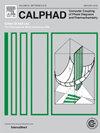User-friendly and robust Calphad optimizations using Calphad Optimizer in FactSage
IF 1.9
3区 材料科学
Q4 CHEMISTRY, PHYSICAL
Calphad-computer Coupling of Phase Diagrams and Thermochemistry
Pub Date : 2025-01-29
DOI:10.1016/j.calphad.2025.102800
引用次数: 0
Abstract
The Calphad Optimizer available since FactSage 8.2 is presented. It contains both a user-friendly graphical interface, as well as input and output files that are easily readable by humans and machines. For a number of typical experiments (liquidus and solidus temperatures, two-phase equilibria, heat of mixing, heat of reaction, enthalpy increment) tailored recipes exist to enable beginners and non-specialists the input of the relevant data. For many other experimental data, user-defined experiments can also be created. Two different optimizers are currently implemented. While running the optimization, the user is presented with graphs showing the convergence progress, both globally (error sum vs. iteration), as well as for each experiment (comparison between experimental and calculated data) and for each optimization parameter (error sum vs. parameter value). As a first post-processing option, phase formation maps can be calculated.
In the latest version of the Calphad Optimizer, available since FactSage 8.3, the error sum is calculated primarily based on Gibbs energy differences, not the raw experimental data. The details of the implementation are described. Using the Pb-Sn and Cr-Ni systems as examples, we show how the change in the error sum calculation increases robustness and speed of the optimization, making one-shot Calphad database optimizations possible.
使用FactSage中的Calphad优化器,实现用户友好且强大的Calphad优化功能
介绍自 FactSage 8.2 开始使用的 Calphad 优化器。它既有用户友好的图形界面,也有人机易读的输入和输出文件。对于一些典型的实验(液相和固相温度、两相平衡、混合热、反应热、焓增量),有专门的配方供初学者和非专业人员输入相关数据。对于许多其他实验数据,也可以创建用户自定义实验。目前有两种不同的优化器。在运行优化过程中,用户可以看到收敛进度图,包括全局收敛进度图(误差总和与迭代次数的关系)、每个实验收敛进度图(实验数据与计算数据的比较)以及每个优化参数收敛进度图(误差总和与参数值的关系)。作为第一个后处理选项,可以计算相位形成图。在 FactSage 8.3 开始使用的最新版 Calphad 优化器中,误差和的计算主要基于吉布斯能量差,而不是原始实验数据。本报告介绍了实施的细节。我们以铅-锑和铬-镍体系为例,展示了误差和计算方法的改变如何提高了优化的稳健性和速度,使 Calphad 数据库的一次优化成为可能。
本文章由计算机程序翻译,如有差异,请以英文原文为准。
求助全文
约1分钟内获得全文
求助全文
来源期刊
CiteScore
4.00
自引率
16.70%
发文量
94
审稿时长
2.5 months
期刊介绍:
The design of industrial processes requires reliable thermodynamic data. CALPHAD (Computer Coupling of Phase Diagrams and Thermochemistry) aims to promote computational thermodynamics through development of models to represent thermodynamic properties for various phases which permit prediction of properties of multicomponent systems from those of binary and ternary subsystems, critical assessment of data and their incorporation into self-consistent databases, development of software to optimize and derive thermodynamic parameters and the development and use of databanks for calculations to improve understanding of various industrial and technological processes. This work is disseminated through the CALPHAD journal and its annual conference.

 求助内容:
求助内容: 应助结果提醒方式:
应助结果提醒方式:


